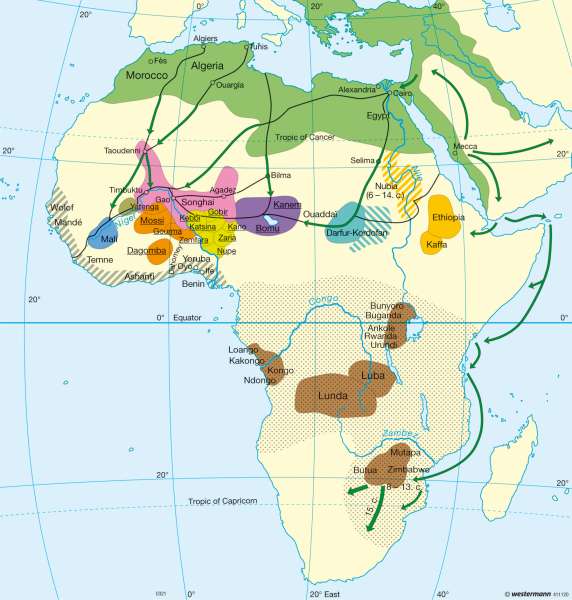African states in the 15th — 17th centuries
Africa - Countries and history
978-3-14-100790-9 | Page 154 | Ill. 1

Information
The African continent of the early modern period indicates a belt of African kingdoms to the north of the equator and a few scattered kingdoms on the coasts and in the interior of the south. Before the birth of Christ, the Bantu peoples had infiltrated through the equatorial rain forest to the south and set up three centres power there: the Congo Empire at the mouth of the Congo river and northern Angolan region of Lunda, Zimbabwe and its successor state Monomotapa as well as the Hima states on Lake Victoria. In East Africa, South Arabian tribes founded the kingdom of Aksum, the future Ethiopia, around 100 AD. The origin of the legendary Ghana is dated to around 400 AD, as the precursor of Mali.Rich sub-Saharan
Ghana, the "Land of Gold," owed his legendary wealth to salt and gold deposits. In 997, the Arab historian Ibn Haukal stated that "the King of Ghana is the richest man on earth". Up until this time, the empire stretched from the Atlantic coast to an area near Timbuktu and allegedly possessed an army of 200,000 men. However, in the 11th Century, skirmishes with the Almoravids, a Muslim revivalist movement, led to its demise.
The succession of Ghana went to the Empire of Mali, whose chieftains soon embraced Islam. Under Sundjata, the "Lion of Mali", the kingdom included the region from the mouth of the Senegal estuary to the "great bend" of the Niger and from Walata in Mauritania to the mountains of the south. The wealth of the Malinke was based on trans-Saharan trade and control over the goldfields of Wangara. The pilgrimage of King Musa to Mecca in 1324 is legendary, where within a short time the value of gold inflated because the giving of alms.
Towards the end of the 14th Century, Mali had already been weakened by invading tribes in the south and north. In 1435, the Tuareg captured the capital of Timbuktu, but it was the Songhai who took over. Under Sonni Ali they seized the most powerful state in central Sudan. The Songhai were defeated in 1591 by Moroccan and Spanish conquistadors which ended Sudan's era as a major power. Trade shifted to the coasts with the arrival of the Europeans. The impoverished inland states in the coastal regions created new empires, such as Yoruba and Benin. They lived mostly off the thriving slave trade with the Portuguese, Dutch and English trading posts, which were established on the coast from the 16th Century.
The resulting 1,000 Hausa city-states — including Gobir, Katsina, Kano and Zaria — had been Islamised in around 1350. The slightly younger kingdoms of the Mossi probably go back to the 11th or 12th Century. The Kanem-Bornu empire founded in the 8th Century, north of Lake Chad, was Islamised in the 11th Century and reached its greatest extent in around 1200. It achieved prosperity as a trading hub between the northern Arabs and the rich West and South Africans. After riots and attacks, the centre of the empire relocated to Bornu in 1400, where it experienced a new golden age in the 16th Century. The Saif dynasty which reigned for more than 1,000 years, ended in 1846 with the execution of the last sultan.
The West African coastal kingdoms were unaffected by the advance of Islam. Cities of the Yoruba people had up to 100,000 inhabitants and their founding city state of Benin became a centre for the slave trade.
D. Bode, K. Lückemeier; Ü: C. Fleming




